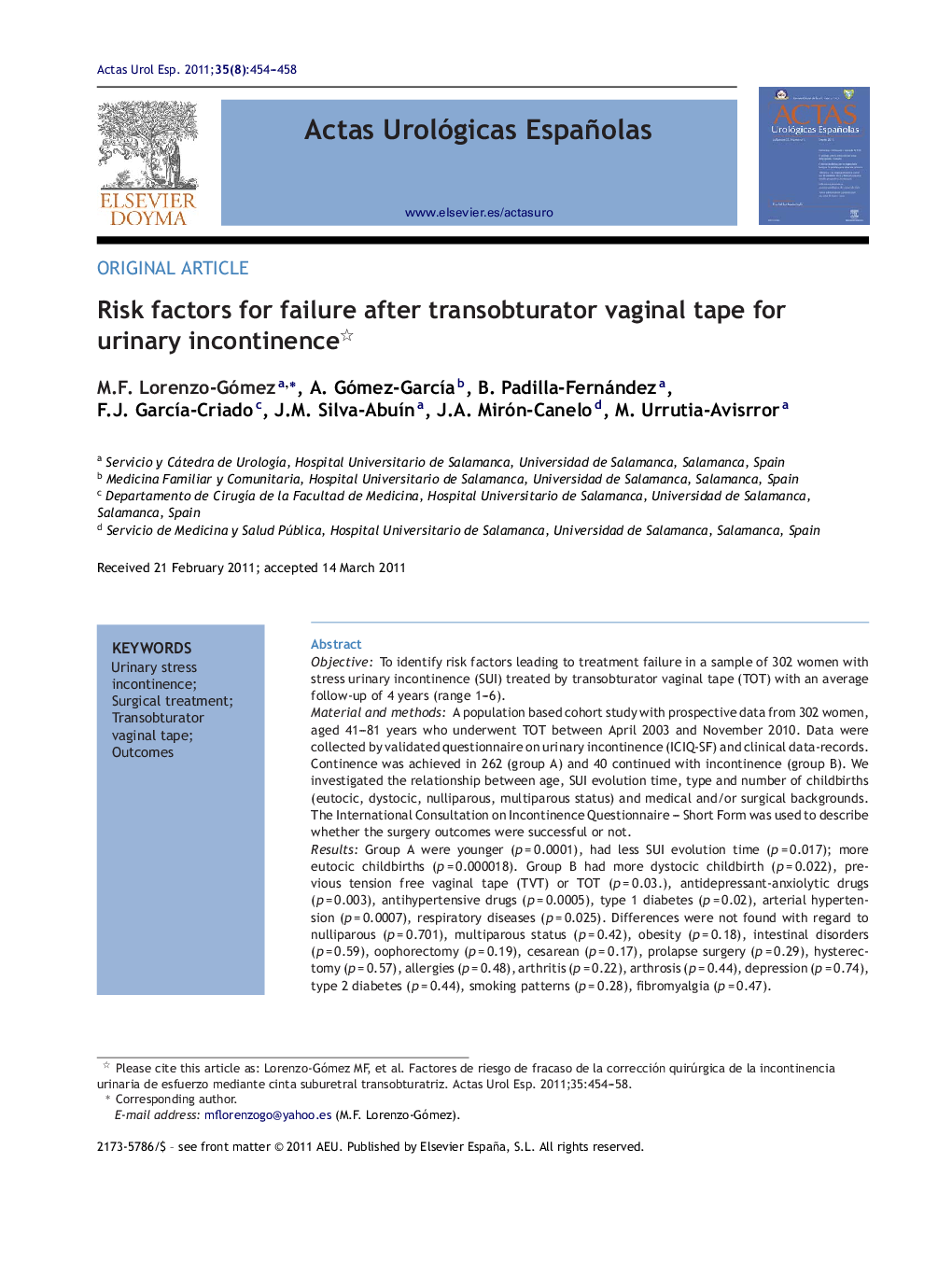| کد مقاله | کد نشریه | سال انتشار | مقاله انگلیسی | نسخه تمام متن |
|---|---|---|---|---|
| 3845686 | 1248285 | 2011 | 5 صفحه PDF | دانلود رایگان |

ObjectiveTo identify risk factors leading to treatment failure in a sample of 302 women with stress urinary incontinence (SUI) treated by transobturator vaginal tape (TOT) with an average follow-up of 4 years (range 1–6).Material and methodsA population based cohort study with prospective data from 302 women, aged 41–81 years who underwent TOT between April 2003 and November 2010. Data were collected by validated questionnaire on urinary incontinence (ICIQ-SF) and clinical data-records. Continence was achieved in 262 (group A) and 40 continued with incontinence (group B). We investigated the relationship between age, SUI evolution time, type and number of childbirths (eutocic, dystocic, nulliparous, multiparous status) and medical and/or surgical backgrounds. The International Consultation on Incontinence Questionnaire – Short Form was used to describe whether the surgery outcomes were successful or not.ResultsGroup A were younger (p = 0.0001), had less SUI evolution time (p = 0.017); more eutocic childbirths (p = 0.000018). Group B had more dystocic childbirth (p = 0.022), previous tension free vaginal tape (TVT) or TOT (p = 0.03.), antidepressant-anxiolytic drugs (p = 0.003), antihypertensive drugs (p = 0.0005), type 1 diabetes (p = 0.02), arterial hypertension (p = 0.0007), respiratory diseases (p = 0.025). Differences were not found with regard to nulliparous (p = 0.701), multiparous status (p = 0.42), obesity (p = 0.18), intestinal disorders (p = 0.59), oophorectomy (p = 0.19), cesarean (p = 0.17), prolapse surgery (p = 0.29), hysterectomy (p = 0.57), allergies (p = 0.48), arthritis (p = 0.22), arthrosis (p = 0.44), depression (p = 0.74), type 2 diabetes (p = 0.44), smoking patterns (p = 0.28), fibromyalgia (p = 0.47).ConclusionsOld age, long evolution SUI, dystocic delivery and a previous TVT or TOT appear as independent risk factors associated to TOT failure. These factors may make the indication of another surgical approach recommendable.
ResumenObjetivosIdentificar factores que llevaron al fracaso del tratamiento quirúrgico en 302 mujeres con incontinencia urinaria de esfuerzo (IUE) tratadas mediante cinta suburetral transobturatriz (TOT) con seguimiento de 4 años (rango 1–6).Material y métodos302 mujeres incontinentes de 41–81 años fueron intervenidas mediante TOT entre abril de 2003 y noviembre de 2010. Los datos se recogieron mediante el cuestionario validado para incontinencia de orina (ICIQ-SF) y los registros clínicos de la historia. En 262 se consiguió continencia (grupo A) y 40 siguieron incontinentes (grupo B). Se investigó: edad, tiempo de evolución de IUE, tipo y número de partos (eutócicos, distócicos, nuliparidad, multiparidad) y antecedentes médicos y/o quirúrgicos. Se empleó el cuestionario ICIQ-SF para asignar si los resultados de la cirugía fueron o no exitosos.ResultadosEl grupo A presentó menor edad (p = 0,0001), menos tiempo de evolución de IUE (p = 0,017) y más partos eutócicos (p = 0,00002). El grupo B presentó más partos distócicos (p = 0,002), colocación previa de cinta vaginal libre de tensión (TVT) o TOT (p = 0,03), tratamiento antidepresivo-ansiolítico (p = 0,003), tratamiento antihipertensivo (p = 0,0005), DMID (p = 0.02), HTA (p = 0,0007), trastornos respiratorios (p = 0,025). No hubo diferencia en nuliparidad (p = 0,7), multiparidad (p = 0,4), obesidad (p = 0,18), trastornos intestinales (p = 0,59), anexectomía (p = 0,19), cesárea (p = 0,17), colposuspensión (p = 0,29), histerectomía (p = 0,57), alergias (p = 0,48), artritis (p = 0,22), artrosis (p = 0,44), depresión (p = 0,74), DMNID (p = 0,44), tabaquismo (p = 0,28) o fibromialgia (p = 0,47).ConclusionesEdad avanzada, largo tiempo de evolución de la incontinencia urinaria, antecedentes de partos distócicos y la colocación de TVT o TOT previamente aparecen como los factores independientes más asociados al fracaso del TOT, y pueden hacer aconsejable la indicación de otra técnica quirúrgica.
Journal: Actas Urológicas Españolas (English Edition) - Volume 35, Issue 8, September 2011, Pages 454–458